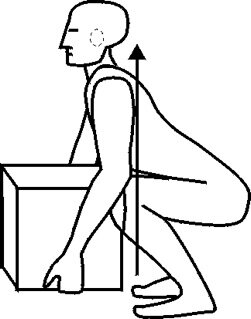Posture and Ergonomics
-While standing, it is important to maintain a light contraction of the abdominal muscles, i.e.: slightly suck in the stomach.
-It is also important to avoid letting the shoulders slouch forward. Hence, the head will not translate forward and will not increase tension between the shoulders and in the neck.
-Taking sufficient micropauses during the day helps maintain an optimal posture.
-While sitting, It is also important to avoid letting the shoulders slouch forward. Hence, the head will not translate forward and will not increase tension between the shoulders and in the neck.
-It is important to use a chair with proper low back support. Chairs that do not offer lumbar support, or worse, that have a support that is too high, can encourage the shoulders to slouch forward.
-Taking sufficient micropauses and rocking the perlvis back and forth helps to maintain a better posture.
-It is important to avoid crossing the legs, except while taking a micropause.
-Ideal sleeping positions are on the sides and on the back.
-However, certain injuries can prevent us from sleeping in these positions.
-Alternating between both sides and the back, during the night, reduces the prolonged stretching or shortening of the same structures, thus preventing tissue fatigue and eventually many injuries.
-Placing one or two pillows under the knees while lying on the back will reduce the tension on the lower back.
-This is even more crucial when the individual has low back pain.
-Placing a pillow between the knees while lying on the side will reduce the tension on the lower back and pelvis.
-A body pillow allows the person to have something in there arms and between the knees, hence preventing the arms from raising up (in addition to helping the lower back and pelvis).
-On the side, the thickness of the pillow must allow the head to stay aligned with the spine.
-It is important to remember that the ideal thickness of a pillow can change if the firmness of the mattress changes because our body will not sink into the bed the same way.
-While on the back, the pillow must not be too high or too low because the head and the neck would not be properly supported.
-The lower third part of the pillow must be in the neck, hence supporting the normal curvature of the neck while the head sinks into the pillow.
-Upon lifting an object, it is important to use our legs, but it is also important to use our back.
-The pelvis must be slightly rocked forward, but the back must be straight and contracting to avoid exaggerated stress on the joints and disks.
-The back is bending forward, but straight.
-The back and shoulders must not be slouching.
-The abdominal muscles must be contracting.
-The object must be as close as possible to the person.
-The knees should not pass in front of the toes (a little is actually perfect if the ankles and hips are flexible enough and the heels are touching the ground), especially if the person is using a lounge to put one knee on the ground.
-It is important to follow the advice above for an ideal sitting posture.
-The person’s elbows must be at 90 degrees when using the keyboard or mouse.
-The person’s elbows must be able to rest on armrests.
-The person’s knees must be at 90 degrees. If the person is too short, a footrest can help.
-The person must be able to see the screen without bending the head (ideally, the person should be able to use the keyboard without looking at it).
-The necessary tools and equipment must be easily accessible. The person must not have too stretch or turn too far to use the tools or equipment he or she needs.
-It can be very easy to make a portable computer ergonomic.
-A USB mouse and keyboard can be very low in cost.
-It is also very simple to put the computer on a few thick books to allow the screen to be at the optimal height.






